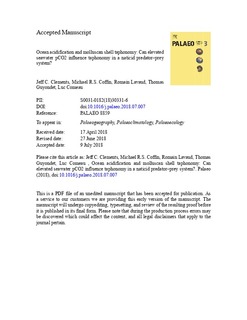Ocean acidification and molluscan shell taphonomy: Can elevated seawater pCO2 influence taphonomy in a naticid predator–prey system?
Journal article, Peer reviewed
Accepted version

Åpne
Permanent lenke
http://hdl.handle.net/11250/2596387Utgivelsesdato
2018Metadata
Vis full innførselSamlinger
- Institutt for biologi [2575]
- Publikasjoner fra CRIStin - NTNU [38127]
Originalversjon
Palaeogeography, Palaeoclimatology, Palaeoecology. 2018, 507 145-154. 10.1016/j.palaeo.2018.07.007Sammendrag
The size and frequency of gastropod drill holes in shells of their prey are common indicators of predator-prey ecology in the fossil record. Taphonomic processes occurring after predation, however, can influence the preservation of shells in a given fossil assemblage and can thus influence ecological inferences based on preserved shells. To determine if ocean acidification (OA) has the capacity to influence prey shell taphonomy in a gastropod drilling predation system, we tested for effects of elevated pCO2 on dissolution rates, breakage force, and drill hole diameters in non-fragmented shells of two prey species of the cannibalistic naticid gastropod, Euspira heros. Drilled and non-drilled shells of Littorina littorea and E. heros were exposed to control (~300 μatm) and elevated (~800 and 4000 μatm) pCO2 treatments for five weeks. Dry shell weight and drill hole diameter (outer and inner) were recorded for individual shells before and after exposure; the force required for shell breakage was recorded at the end of the exposure period. Shell mass loss in 800 and 4000 μatm, respectively, were ~1 and 7% for E. heros, and ~0 and 4% for L. littorea, compared to ~0% in the control for both species. Shell breakage force was unaffected by elevated pCO2, but was affected by species and drill hole presence, with E. heros shells requiring a force of ~220 and 269 Newtons in drilled and non-drilled shells, respectively, compared to ~294 and 415 Newtons in L. littorea. At 4000 μatm, outer drill hole diameter significantly increased by ~12% for E. heros, while inner drill hole diameter significantly increased by ~13% in E. heros and ~10% in L. littorea. Ultimately, this study provides the first documentation of molluscan shell taphonomy in the context of OA for a gastropod drilling predation system and sets the stage for future research.
